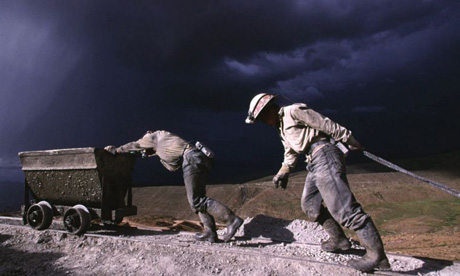
(above) Miners push and haul wagons of rocks dug manually from a cooperative mine
in Cerro Rico mountain in Bolivia. The rocks contain tin, zinc and silver.
(Photograph: Julie Plasencia/AP)
Bolivia: Awakening a 'mountain that eats men'
August 21, 2008 - The Guardian
Indigenous workers find mixed rewards at infamous Spanish colonial silver mine
by Rory Carroll and Andres Schipani
POTOSI -- It was called the "mountain that eats men", and from its slopes you can sense why. The cone, a soaring Andean peak, is lacerated with gaping holes and tunnels. At sunset its rocky surface glows red, as if burning.
This is Cerro Rico, a majestic mountain in Bolivia that was once the world's greatest treasure trove, an immense silver mine that for centuries bankrolled Spain's empire. A silver bridge from here to Madrid could have been built with enough of the precious metal left to carry across it, went the legend.
A grimmer version said you could do likewise from the bones of the miners who died here. Hundreds of thousands of Incas and other indigenous slaves - some say millions - succumbed to horrific working conditions. Lung diseases, mercury poisoning, exhaustion, accidents, all took their toll.
"Our ancestors suffered here," said Marco Quispe, 41, an indigenous miner. "But things are different now. For our people these are good, happy days."
A reversal is supposedly unfolding at Cerro Rico, which means Rich Hill. The mine that enriched Europe and doomed natives is finally benefiting indigenous Bolivians, the poorest group in South America's poorest country.
The government granted small indigenous-run cooperatives the right to extract the silver, zinc and tin in the 1980s after the state-owned mining company collapsed. But prices were so low it was barely worth scrabbling for the dregs left by the Spaniards.
In the past four years, however, the scene has transformed. A commodities boom driven by demand in China and India has sent metal prices rocketing and revived the fortunes of the mine and, so it seems, its miners. Their ranks have been swollen by thousands of men, women and children, new miners, who have enthusiastically flocked to the mountain which "ate" their ancestors.
"It's good money," said Mario Ari, 17, a new arrival, finishing a shift at a tunnel called La Negra.
Wages hover around £3 a day, lucrative by Bolivian standards. The workforce has doubled since 2004 to more than 15,000, with most recruited by the cooperatives. Miners are better organised and equipped than before, said Benedicto Colque, a regional head of Fedecomin, the cooperatives' umbrella group.
Signs of wealth are ubiquitous. Hummers and Land Cruisers have replaced wheezing bangers around the narrow streets of Potosi, the colonial city which sprang up around the mine in the 16th century and for a time eclipsed London and Paris in size and splendour.
Property prices have tripled, new bars and restaurants have opened, as have brothels. "There is energy and dynamism, this is a rebirth for Potosi," said Rubén Ruiz, the director of Casa Nacional de Moneda, an imperial mint-turned museum.
Cerro Rico's indigenous-friendly boom seems to embody Bolivia's zeitgeist led by Evo Morales, the country's first indigenous president who swept to office two years ago, promising a peaceful revolution to empower the long-marginalised indigenous majority.
It would also represent symbolic compensation for the lives and treasure lost to Europe. Potosi's baroque glory ended when silver output dwindled in the 1800s, leaving it a ghost town marooned at 4,000 metres (13,000ft) above sea level. But just as Morales's ambitious egalitarian reforms have stalled, so the transformation of Potosi into a good news story is hitting obstacles. Behind the facade of progress lies an old story of exploitation and blighted lives.
Just ask Elmer Ramirez, a 14-year-old who has spent the past two years drilling and inhaling dust in the mountain's dank labyrinths, one of countless child miners. "I've lost my father to lung disease and I only have my mother," he said. "I came here because we needed the money but it is not always enough and the work is very hard."
There are electric torches and drills, but conditions remain largely unchanged from colonial times. Lacking proper masks or safety equipment miners swiftly succumb to lung diseases, said Felicidad Choque, a doctor at Potosi's main hospital. "They die young, just 45-years-old, even 35."
A ward with men attached to oxygen masks bore wheezing, rasping testimony to the epidemic. "They've tried but they say they can't cure me," said Antonio Flores, 55, a veteran driller who has had tuberculosis and silicosis. "The mountain," he added, pausing for breath, "it still takes lives."
Potosi has struggled to convert booms from previous centuries into sustainable development and this time may be no different, said Luis Prado, an architect and head of a civic restoration association. Apart from tourism, a growing industry, the local economy remained hostage to commodity prices. "We are a lesson in what not to do," he said.
The small indigenous-run mining cooperatives are autonomous and run their own affairs but the biggest profits are still pocketed by middlemen, just like the old days, said Prado. "The cooperatives are a mask for a few rich people. Today we no longer have colonialism; we have a form of primitive capitalism. The exploitation continues."
Working in the bowels of Cerro Rico may no longer be a definite death sentence but it is a gamble. Outside a tunnel a group of young diggers, coated in grey dust, went silent when asked where they envisaged themselves in a decade's time. "In the cemetery like everyone else," said one, a half-joke. His colleagues smiled queasily.